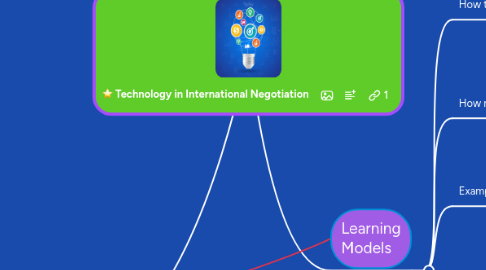
1. Learning Models
1.1. How things are said in English.
1.1.1. what it is and why you need it
1.1.2. Unconscious learning process
1.1.3. Read and listen to sentences in English
1.2. How much information do you need?
1.2.1. Must know the meanings and pronunciations of something like 10,000 words
1.2.2. Use different words and how they are combined with other words
1.3. Example of learning by grammar rules
1.3.1. Needs Memory Effort
1.3.2. Grammar rules only follow native speakers' habits.
1.4. super-fun, thrilling and funny sources of English
1.4.1. It's a way to learn English
1.4.2. The fun allows you to change your attitude to English
1.5. Formal and informal English
1.5.1. Formal English is used in "serious"
1.5.2. Informal English is used in everyday conversations and in personal letters.
1.6. Reading is easier than listening
1.6.1. While reading, you have as much time as you want.
1.6.2. Reading is the fastest way to learn a lot of English words and grammatical structures
1.7. Watching movies in English
2. communication skills
2.1. Listening
2.1.1. Listening skills
2.1.1.1. What is driving us to do this?
2.1.1.2. SWOT Analysis
2.1.1.2.1. Strengths
2.1.1.2.2. Weaknesses
2.1.1.2.3. Opportunities
2.1.1.2.4. Threats
2.1.1.3. Customer Findings - What have we learned from customers?
2.1.2. Competitive Analysis
2.1.2.1. Do we have competitors and threats in these target markets with the proposed offerings?
2.1.2.2. What are our competitors doing and how are they positioning?
2.1.2.3. How do we position against each competitor?
2.1.3. Target
2.1.3.1. Buyer Profile
2.1.3.1.1. Title
2.1.3.1.2. Industry
2.1.3.1.3. Geography
2.1.3.1.4. Business Size
2.1.3.2. Influencer Profile
2.1.3.3. User Profile
2.1.3.4. What do customers want and need?
2.1.3.5. What business problems do each of these customers have?
2.1.4. Attend presentations
2.1.4.1. Which customers or sets of customers do we sell to?
2.1.4.2. What are the target market segments that we want to go after?
2.1.4.3. What are the distinct problems for each segment of the market?
2.1.5. Ask questions and take notes
2.1.5.1. New Prospects
2.1.5.1.1. How much of each target segment have we penetrated?
2.1.5.1.2. How much opportunity is available in each target segment?
2.1.5.2. Existing Customers
2.1.5.2.1. Can we up-sell existing customers?
2.2. Reading
2.2.1. Read in English every day
2.2.1.1. What are we selling?
2.2.1.2. Product Definition
2.2.1.3. Pricing
2.2.1.4. Packaging
2.2.1.5. Positioning
2.2.2. Technical understanding
2.2.2.1. What is the Value Proposition to the Customer?
2.2.2.2. What pain are we solving?
2.3. Writing
2.3.1. Use formal and informal styles
2.3.1.1. Revenue and P&L Forecast (5 Years)
2.3.1.2. Revenue should be split out quarterly
2.3.2. Technical writing styles
2.4. Speaking Skills
2.4.1. Conversation skills
2.4.1.1. Direct Sales Strategy
2.4.1.2. Inside Sales Strategy
2.4.1.3. Channel Sales Strategy
2.4.2. Diction and inflection are important
2.4.2.1. Channel Strategy
2.4.2.1.1. What 3rd party channels should we consider for reselling this service?
2.4.2.2. Technology Partnerships
2.4.2.2.1. What technology vendors (if any) do we need to work with to execute on this plan?
2.4.2.3. Solutions Partners
2.5. Vocabulary Skills
2.5.1. Ability to be concise
2.5.1.1. What is the key messaging and positioning for the service offer? (Pain, alternatives, solution)
2.5.1.2. How do we communicate internally?
2.5.1.3. How do we communicate externally?
2.5.2. Broad vocabulary
2.5.2.1. Marketing Programs (Installed base versus new prospects)
2.5.2.2. Advertising (Publications, etc.)
2.5.2.3. Analyst Relations (Target Analysts)
2.5.2.4. Public Relations
2.5.2.5. Events (Trade shows, SEO/SEA, Seminars)
2.5.2.6. Webinars
2.5.3. Select the correct words accurately
2.5.3.1. How do we generate and qualify new leads for the target offer?
2.5.3.2. Prospect Lists
2.5.3.3. Key Questions to Ask
2.5.3.4. Sales Collateral
2.5.3.5. Presentations
2.5.3.6. Data Sheets
2.5.3.7. White Papers
2.5.3.8. ROI Tools
2.5.3.9. Other Sales Tools (web site, etc.)
2.6. Nonverbal Skills
2.6.1. Use the key
2.6.2. Body language that matches the words
2.6.3. Accelerated Learning Strategy, Controls, Metrics
2.6.4. Include feedback loops
2.6.5. Skills: diction, empathy, voice control
2.6.6. Pipeline reports, etc…

